

 |
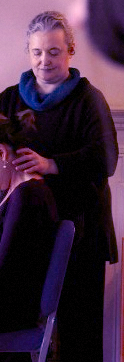 |





Alexander Technique: The Insiders’ Guide
The F. M. Alexander Technique
by Marian Goldberg
We are often unaware of habits that cause us stress and interfere with our ability to respond effectively to the stimuli in our daily lives. How can we change our habits so that we can respond more effectively and achieve better functioning? This fundamental problem is addressed and dealt with in the Alexander Technique, a method that has been recognized for over one-hundred years as a unique and remarkably effective technique of mind-body reeducation.
A Brief History
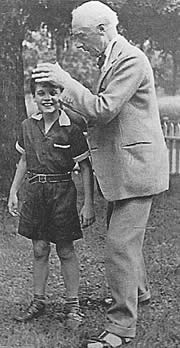 |
| Photo © 2010 The Society of Teachers of the Alexander Technique, London |
| F. M. Alexander teaching child (1940s). |
Alexander had also made the discovery that breathing and vocalization are part and parcel of how the body functions as a whole. Habitual breathing and vocal patterns are parts of habitual patterns of general coordination. In fact, many problems we see as involving just one particular part of the body, e.g. lower back pain and “RSI,” are often symptoms of larger habitual patterns of malcoordination.
Just as people had found Alexander's “vocal” technique helped them with their breathing problems, so a number of his students found his method of respiratory re-education helped them with other physical difficulties. Basically, Alexander had evolved a method for learning how to consciously change maladaptive habits of coordination. (Coordination includes movement, posture, breathing, and tension patterns.) He had come to the understanding that the mind and body function as an integrated entity, a rather unusual realization for that time.
Alexander found that habits, whether “physical” habits or “mental” habits, are all psychophysical in nature. He observed that how we think about our activities determines how we coordinate ourselves to do those activities, and, equally, how long-held habits of excessive tension and inefficient coordination affect how we feel and think. In a relatively short period of time, Alexander evolved his technique from a method of vocal training into a method of breathing reeducation and then into a comprehensive technique of psychophysical reeducation. His technique deals with the psychophysical coordination of the whole person, or what he termed more concisely as “the use of the self.”
Try This:
Try to breathe from high up in your chest or from low
down in your abdomen. Try walking or moving your arms while you breathe in one
of these ways. Do you walk or move your arms differently when you change your
breathing? Or make a conscious effort to change the way you walk or the way you
hold your neck, or try clenching your arms: Do these efforts affect your breathing
or your voice? What if these were habitual efforts—efforts which you made all
the time but you were unaware that you were making them? We do make habitual excessive
efforts most of the time, but we are generally unaware of making them. Excessive
stress in one part of the body is usually part of a larger pattern of habitual
malcoordination.
How Habits Affect Our Functioning
How do habits develop? We can see how habits develop by observing the movements of a child. Babies are usually born with an overall fundamental pattern of coordination “programmed” into their nervous systems. This primary pattern works efficiently and easily with the human structure. An example of this natural efficiency of the human mechanism can be seen with a baby who spontaneously sits up by himself. Generally, a baby of 12 months sits very upright naturally. In fact, it is far easier and more natural for a baby to sit upright than for the typical adult who slouches into a supposedly “relaxed” movement/postural pattern.
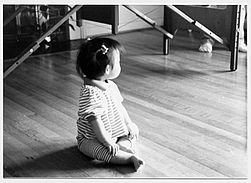 |
| Photo © 1996, 2015 Marian Goldberg |
| The natural poise of a baby. |
Maladaptive habits alter our general sensory feedback.They alter our perceptions of what feels “right”: These altered perceptions and concomitant feelings affect everything we do which involves our coordination. And all activities, whether “physical” or “mental,” involve coordination, or the way we use ourselves.
Learning the Alexander Technique
What one learns in Alexander Technique lessons is a unique and practical means of stopping and changing habits. This learning process allows one's sense of coordination to regain its natural “perspective.” The Alexander Technique teacher takes the student through basic movements giving gentle hands-on guidance. Through this guidance, the student experiences more natural and easy coordination without the on-going interference of habits. Repeating and expanding on these experiences of natural, fundamental movement stimulates the student's internal coordination mechanisms to become more accurate. This develops his/her ability to choose better coordinated, non-habitual, and non-stressful responses to stimuli. The student is able to make lasting habit changes.
The Alexander Technique is based on an unusual, if not unique, paradigm that is very unlike medical, treatment, and exercise models. It does not involve exercises, medical therapy or treatment, forms of psychotherapy, or spiritual healing techniques. It is also unlike the manipulations of bodywork or manual therapy methods: Rather than looking at the body as a set of separate “parts” or pressure points to be individually “worked on,” a skilled teacher works with the system as whole—guiding the student through movement, observing and working with whole patterns of coordination, which include tension and postural patterns, how the student thinks about moving, and active movement itself. The student actively participates in this fascinating and very rewarding process, learning to apply his/her own intelligence to effectively change habits.
|
|
Benefits of the Alexander Technique
Learning the Alexander Technique can have many benefits, including freer and more comfortable movement, relief from strain, chronic pain, and excess tension, more comfortable and erect posture, greater self-awareness and enhanced mindfulness in everyday life, easier and healthier breathing, increased vitality and strength, improved balance, and, most importantly, the development of skills that can be used to change habits that interfere with optimal functioning. The fundamental improvement in the reliability of sensory appreciation and awareness that occurs with Alexander Technique lessons can lessen the risk of future injuries and chronic pain problems. This in-depth improvement also has positive, significant effects on a wide range of behaviors and skills, including the ability to learn.
The Technique can be very helpful for people dealing with chronic pain, excessive stress, or injury. It is also used by performing
artists to enhance performing techniques. A number of universities and conservatories
incorporate the Alexander Technique into their regular curriculum. John Dewey,
the American philosopher, studied the technique for over 35 years and expressed
a strong wish that the Alexander Technique be incorporated into the educational
system. Charles Sherrington, the Nobel laureate in physiology, stated of Alexander's
work, “Mr. Alexander has done a service to the subject by insistently treating
each act as involving the whole integrated individual, the whole psychophysical
man.”
See: British Medical Journal Study: Alexander Technique lessons with STAT-certified teachers provide significant long-term benefit for patients with back pain.
Alexander Technique Testimonials
British Medical Journal Study: Results of Alexander Technique
lessons with STAT-certified Alexander Technique Teachers.
Alexander Technique teacher Alex Murray, at the age of 85, is a wonderful
example of the benefits and advantages (agility, poise, etc.) of practicing
the Technique. This is a spontaneous postscript to a
talk on
the Alexander Technique.
Alexander Technique Lessons
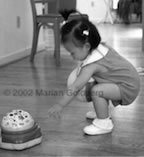 |
| A small child squats with an easy, comfortable and natural balance. |
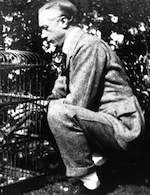 Photo © 2014 The Society of Teachers of the Alexander Technique, London |
| F. M. Alexander with the same easy, natural, and comfortable balance as the chlld pictured above. |
An Alexander Technique student learns to change tension habits that have been built up over a course of a lifetime. Private lessons focus on the individual student learning and applying the Principles of the Technique in ways that are most effective and beneficial for him/her. The number of lessons a student may choose to take may be based on several factors, including his or her individual conditions, rate of progress, and the particular improvements he or she may be seeking.
F. M. Alexander generally recommended that students take at least thirty private lessons. While most students experience significant improvements with fewer lessons, a series of thirty lessons provides students with the best opportunity to make very substantial and lasting positive changes in deep-rooted tension habits. A series also provides students with the instruction and time needed to learn the Principles of the Technique well enough to continue to progress on their own after they stop taking lessons.
A prospective student usually takes an introductory lesson(s), and then decides if he/she would like to continue taking lessons. It's recommended that new students take lessons at least one or more times a week. Generally, it's better to have lessons one or more times a week than to have lessons less frequently over a longer period of time.
For people who are unable to take lessons on a regular basis, a series of lessons can be taken in smaller sets. For example, a person may take a set of three to five lessons and then have another set of three to five lessons several weeks or months later. Between sets of lessons, the student can use what he/she has learned to help maintain improvement and awareness.
See: Alexander Technique Lessons FAQs.
Alexander Technique Workshops and Classes
Alexander Technique workshops can provide an informative introduction to the Technique and can offer helpful hints when private instruction is not available. However, since classes attempt to teach the Alexander Technique in a group setting, the actual learning of the Technique is limited as they lack sufficient experience in the hands-on guidance that provides for making substantive changes in habits.
Although F. M. Alexander did briefly try at one point early in his teaching career to teach the Technique to a group class, he apparently did not find this effective, particularly in comparison to private lessons that focus on each individual's unique habits and use. Despite that Alexander greatly enjoyed and had considerable success with speaking and performing to groups as an actor and reciter, he chose to teach his Technique on an individual basis through private lessons throughout the almost 60 years he taught his Technique. The only exceptions to this were small classes with people who already had a considerable number of private lessons: his teacher-training course and, for a few years, a small class for children. In his teaching, speaking, and writing, F. M. Alexander always emphasized the importance of the individual.
Alexander also wrote in his books about the problems people have with the dynamics of what today could be called “group think” or "group mentality." The pressures on the individual to conform or perform—"live up to expectations"—that tend to occur in a group setting often create additional stress and undue tension. Adding unnecessary stress and tension while trying to learn to stop tension habits is clearly counterproductive. This is likely another reason Alexander emphasized learning the Technique on an individual basis through private lessons.
Alexander Technique Teacher Training
Alexander Technique teacher training continues and intensifies the unique learning experience that takes place in private lessons. The training is a fascinating process that is often one of remarkable growth and improvement for the teacher-trainee.
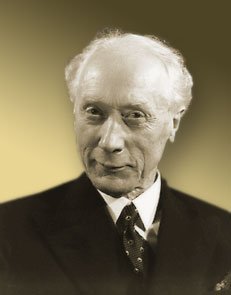 |
| Photo © 2010 The Society of Teachers of the Alexander Technique, London |
| F. M. Alexander |
Recommended reading on Alexander Technique teacher training: Taking Time.
Taking Time eBook.
More on Alexander Technique teacher training.
Finding and Choosing an Alexander Technique Teacher
To gain the wonderful benefits that learning the Alexander Technique can provide, it's important to take the time to learn it from a qualified teacher of the Technique. Qualified teachers have completed intensive full-time courses that meet the three-year, daily training standards established by F. Matthias Alexander.
Alexander Technique teachers have different interpretations of the Technique and teaching approaches vary. It can be helpful to try lessons with several teachers before making a decision to work with a particular teacher. A helpful gauge for deciding on a teacher can be one's own experiences of improvement during an introductory lesson(s). However, depending on circumstances, it can take several lessons before a student notices any changes.
F. M. Alexander used to tell prospective students to read his books before starting lessons. Reading about the Alexander Technique can also be helpful in making an informed choice concerning a teacher. Some good introductory books and links to lists of certified teachers are listed below.
Recommended Introductory Books:
The Alexander Technique: Freedom in Thought and Action by Tasha Miller and David Langstroth. Audio book is free on YouTube. Audio download is available from Spotify. Nous Publishing, 2007. ISBN 9780973978629.
Freedom to Change by Frank Pierce Jones. A comprehensive account of the Alexander Technique. (First published
under the title, Body Awareness in Action, 1976.) London: Mouritz, 1997. Available from Mouritz and Amazon.
Recommended Introductory Reading
The Alexander Technique: Freedom in Thought and Action by Tasha Miller and David Langstroth. Audio book is free on YouTube. Audio download is available from Spotify. Nous Publishing, 2007. ISBN 9780973978629.
Freedom to Change by Frank Pierce Jones. A comprehensive account of the Alexander Technique. (First published
under the title, Body Awareness in Action, 1976.) London: Mouritz, 1997. Available from Mouritz and Amazon.
Books by F. M. Alexander include:
The Use of the Self. This is generally considered to be the “easiest to read” of Alexander’s four books. (It’s also the shortest.) It includes Alexander's account of his development of the Technique. With an introduction by American philosopher and educator John Dewey. 1932 ISBN-10: 0752843915, ISBN-13: 978-0752843919. Available from Barnes & Noble.
Constructive Conscious Control of the Individual. Considered by Alexander himself and many others to be his best book. With an introduction by American educational philosopher John Dewey. 1923, 1946, Mouritiz edition 2004 (recommended). ISBN 0-9543522-6-2. Available from Mouritz Publishers and Amazon. Free audio book download from LibriVox.
More information on F. M. Alexander's Books
Recommended Links
Society of Teachers of the Alexander Technique (STAT)—The oldest (established 1958) and largest professional association for the Alexander Technique. All members have completed a full-time, three-year training course. This site includes an international list of teachers and published scientific research.
Alexander Technique Center of Washington Lessons, introductory workshops and presentations, and AmSAT-approved teacher-training program in the Washington area: D.C., Northern Virginia, Maryland.
British Medical Journal Study: Private lessons with STAT-certified (Society of Teachers of the Alexander Technique) teachers provide significant long-term benefit for patients with back pain: http://www.bmj.com/content/337/bmj.a884.
The Core: An Alexander Technique teacher questions common assumptions about exercising “ the core,” referencing scientific literature on coordination, and discusses the basics of healthy, natural, and balanced muscular use from the perspective of the Alexander Technique.
Alexander Technique Teachers' List, Canada (CANSTAT) The Canadian Society of Teachers of the Alexander Technique.
Neuromuscular Anatomy, Child Development, and Evolution for the Alexander Technique. AT Anatomy Weebly by Alexander Murray and Anna LeGrand.
Novis: Publisher of high-quality educational products for the Alexander trainee, teacher and teacher trainer alike, as well as for the serious pupil who wishes to inquire more into the theory and history of the Technique.
Mouritz Press: Specialist publisher of books on the Alexander Technique, including original writings of F. M. Alexander.
Jeff Haas's Alexander Technique links page A selection of links and a small movie of F. M. Alexander giving a lesson.
The F Matthias Alexander Trust is a registered charity (UK) created in 1990 to advance the education of the general public in the Alexander Technique, to promote research and study into all aspects of the Alexander Technique, and to disseminate the useful results of that research.
© 1995, 1999, 2004, 2007, 2010, 2013, 2017 Marian Goldberg
This article is reprinted in the Alternative Medicine Sourcebook (Detroit: Omnigraphics Health Reference Series 2002, ISBN 0-7808-0605-0.). Portions of this article are also reprinted in the Florida Hospital Wellness Program Newsletter, Florida Hospital Rehabilitation and Sports Medicine, June 2000 and in “The Alexander Technique. Learning to Move is Learning for Mind and Body” Natural Awakenings (Arlington, Virginia, March/April 2002 issue). No part of this article may be reproduced or republished without written permission from the copyright owner.
Alexander Technique: The Insiders’ Guide
Web site maintained
by Marian Goldberg, MSTAT
Alexander Technique Center of Washington, D.C.
e-mail: info@alexandercenter.com
 This child has established habits that interfere with his natural coordination and cause him to slouch and use excessive tension as he holds a phone.
This child has established habits that interfere with his natural coordination and cause him to slouch and use excessive tension as he holds a phone.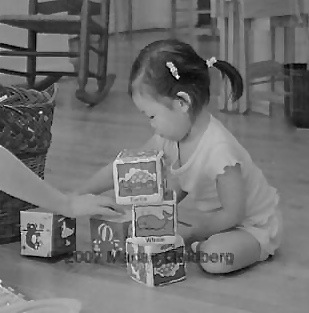 This young child's natural use has not been interefered with by habits. Notice her naturally lengthened back and neck as she easily bends forward to hold the block.
This young child's natural use has not been interefered with by habits. Notice her naturally lengthened back and neck as she easily bends forward to hold the block.